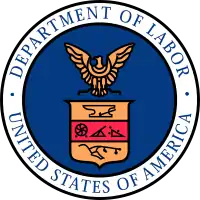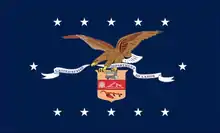United States Department of Labor
The United States Department of Labor (DOL) is a cabinet-level department of the U.S. federal government responsible for occupational safety, wage and hour standards, unemployment insurance benefits, reemployment services, and some economic statistics; many U.S. states also have such departments. The department is headed by the U.S. Secretary of Labor.
 Seal of the U.S. Department of Labor | |
 Flag of the U.S. Department of Labor | |
 The Frances Perkins Building, which serves as the headquarters of the U.S. Department of Labor | |
| Agency overview | |
|---|---|
| Formed | March 4, 1913[1] |
| Headquarters | Frances Perkins Building 200 Constitution Avenue NW Washington, D.C., U.S. 38°53′33.13″N 77°0′51.94″W |
| Employees | 17,450 (2014) |
| Annual budget | $12.1 billion (FY 2012)[2] |
| Agency executive |
|
| Website | www |
The purpose of the Department of Labor is to foster, promote, and develop the wellbeing of the wage earners, job seekers, and retirees of the United States; improve working conditions; advance opportunities for profitable employment; and assure work-related benefits and rights. In carrying out this mission, the Department of Labor administers and enforces more than 180 federal laws and thousands of federal regulations. These mandates and the regulations that implement them cover many workplace activities for about 10 million employers and 125 million workers.
The department's headquarters is housed in the Frances Perkins Building, named in honor of Frances Perkins, the Secretary of Labor from 1933 to 1945.
History
.svg.png.webp)
In 1884, the U.S. Congress first established a Bureau of Labor Statistics with the Bureau of Labor Act,[3] to collect information about labor and employment. This bureau was under the Department of the Interior. The Bureau started collecting economic data in 1884, and published their first report in 1886.[4] Later, in 1888, the Bureau of Labor became an independent Department of Labor, but lacked executive rank.
In February 1903, it became a bureau again when the Department of Commerce and Labor was established. United States President William Howard Taft signed the March 4, 1913, bill (the last day of his presidency), establishing the Department of Labor as a Cabinet-level department. William B. Wilson was appointed as the first Secretary of Labor on March 5, 1913, by President Wilson.[5] In October 1919, Secretary Wilson chaired the first meeting of the International Labour Organization even though the U.S. was not yet a member.[6]
In September 1916, the Federal Employees' Compensation Act introduced benefits to workers who are injured or contract illnesses in the workplace. The act established an agency responsible for federal workers’ compensation, which was transferred to the Labor Department in the 1940s and has become known as the Office of Workers' Compensation Programs.[7]
Frances Perkins, the first female cabinet member, was appointed to be Secretary of Labor by President Roosevelt on March 4, 1933. Perkins served for 12 years, and became the longest-serving Secretary of Labor.
During the John F. Kennedy Administration, planning was undertaken to consolidate most of the department's offices, then scattered around more than 20 locations. In the mid‑1960s, construction on the "New Labor Building" began and construction was finished in 1975. In 1980, it was named in honor of Frances Perkins.
President Lyndon B. Johnson asked Congress to consider the idea of reuniting Commerce and Labor.[8]
He argued that the two departments had similar goals and that they would have more efficient channels of communication in a single department. However, Congress never acted on it.
In the 1970s, following the civil rights movement, the Labor Department under Secretary George P. Shultz made a concerted effort to promote racial diversity in unions.[9]
In 1978, the Department of Labor created the Philip Arnow Award, intended to recognize outstanding career employees such as the eponymous Philip Arnow.[10] In the same year, Carin Clauss became the department's first female solicitor of the department.[11]
In 2010, a local of the American Federation of Government Employees stated their unhappiness that a longstanding flextime program reduced under the George W. Bush administration had not been restored under the Obama administration.[12] Department officials said the program was modern and fair and that it was part of ongoing contract negotiations with the local.[12]
In August 2010, the Partnership for Public Service ranked the Department of Labor 23rd out of 31 large agencies in its annual "Best Places to Work in the Federal Government" list.[13]
In December 2010, then–Department of Labor Secretary Hilda Solis was named the chair of the U.S. Interagency Council on Homelessness,[14] of which Labor has been a member since its beginnings in 1987.
In July 2011, Ray Jefferson, Assistant Secretary for VETS resigned due to his involvement in a contracting scandal.[15][16][17]
In March 2013, the department began commemorating its centennial.[18]
In July 2013, Tom Perez was confirmed as Secretary of Labor. According to remarks by Perez at his swearing-in ceremony, "Boiled down to its essence, the Department of Labor is the department of opportunity."[19]
In April 2017, Alexander Acosta was confirmed as the new Secretary of Labor. In July 2019, Acosta resigned due to a scandal involving his role in the plea deal with Jeffrey Epstein.[20] He was succeeded on September 30, 2019, by Eugene Scalia. Scalia served until the beginning of the Biden administration on January 20, 2021. The present Acting Secretary is Al Stewart, a long time civil service manager in the Department.[21]
Freedom of Information Act processing performance
In the latest Center for Effective Government analysis of 15 federal agencies which receive the most Freedom of Information Act (FOIA) requests, published in 2015 (using 2012 and 2013 data, the most recent years available), the Labor Department earned a D by scoring 63 out of a possible 100 points, i.e., did not earn a satisfactory overall grade.[22]
Agencies, boards, offices, programs, library and corporation of the department
Related legislation
- 1926: Railway Labor Act
- 1949: Fair Labor Standards Amendment PL 81-393
- 1953: Small Business Act PL 83-163
- 1954: Internal Revenue Code PL 83-591
- 1955: Fair Labor Standards Amendment PL 84-381
- 1958: Small Business Administration extension PL 85-536
- 1961: Fair Labor Standards Amendment PL 87-30
- 1961: Area Redevelopment Act PL 87-27
- 1962: Manpower Development and Training Act PL 87-415
- 1962: Public Welfare Amendments PL 87-543
- 1963: Amendments to National Defense Education Act PL 88-210
- 1964: Economic Opportunity Act PL 88-452
- 1965: Vocational Rehabilitation Act amended PL 89-333
- 1965: Executive Order 11246
- 1965: McNamara-O'Hara Service Contract Act
- 1966: Fair Labor Standards Amendment PL 89-601
- 1970: Occupational Safety and Health Act
- 1973: Comprehensive Employment and Training Act PL 93-203
- 1973: Section 503 of the Rehabilitation Act PL 93-112
- 1974: Fair Labor Standards Amendment PL 93-259
- 1974: Vietnam Era Veterans' Readjustment Assistance Act PL 92-540
- 1974: Employee Retirement Income Security Act of 1974 (ERISA) Pub.L. 93-406
- 1975: Revenue Adjustment Act (Earned Income Tax Credit) PL 94-12, 164
- 1976: Overhaul of vocational education programs PL 94-482
- 1976: Social Security Act Amendments (Aid to Day Care Centers) PL 94-401
- 1977: Fair Labor Standards Amendment PL 95-151
- 1977: Federal Mine Safety and Health Act
- 1978: Full Employment and Balanced Growth Act PL 95-523
- 1981: Budget Reconciliation Act PL 97-35
- 1982: Job Training Partnership Act PL 97-300
- 1983: Migrant and Seasonal Agricultural Workers Protection Act PL 99-603
- 1988: Family Support Act PL 100-485
- 1988: Employee Polygraph Protection Act
- 1989: Fair Labor Standards Amendment PL 101-157
- 1990: Omnibus Budget Reconciliation Act PL 101-508
- 1993: Family and Medical Leave Act PL 103-3
- 1993: Omnibus Budget Reconciliation and Bankruptcy Act PL 103-66
- 1996: Small Business Job Protection Act of 1996 PL 104-188
- 1996: Personal Responsibility and Work Opportunity Act PL 104-193
- 1996: Veterans Employment Opportunities Act PL 105-339
- 1998: Workforce Investment Act of 1998
- 2014: Workforce Innovation and Opportunity Act
See also
Notes and references
- "Chapter 1: Start-up of the Department and World War I, 1913-1921". History of the Department of Labor. Retrieved February 4, 2013.
- "FY 2014 Department of Labor Budget in Brief" (PDF). U.S. Department of Labor. U.S. federal government. 2014.
- Bureau of Labor Statistics
- Bls.gov
- William Bauchop Wilson
- Iga.ucdavis.edu
- Bls.gov
- Lowi, Theodore J. (July 1967). "Why Merge Commerce and Labor?". Challenge. 15 (6): 12–15. doi:10.1080/05775132.1967.11469948. ISSN 0577-5132.
- Frum, David (2000). How We Got Here: The '70s. New York, New York: Basic Books. p. 243. ISBN 0-465-04195-7.
- "PER 00-00-001 - ADM 2.1 - Employee Recognition Program | Occupational Safety and Health Administration". www.osha.gov. Retrieved 2017-03-17.
- HISTORY, WISCONSIN WOMEN MAKING. "Carin Clauss (1939-present)". madison.com. Retrieved 2019-05-30.
- Kamen, Al (2010-04-23). "AFGE pushes for flextime at Labor Department". The Washington Post. Retrieved 2010-04-26.
- "Best Places to Work > Overall Index Scores". Partnership for Public Service. 2010. Retrieved 2010-09-01.
- About USICH | United States Interagency Council on Homelessness (USICH). Usich.gov (1987-07-22). Retrieved on 2013-08-12.
- All.gov
- "Raymond Jefferson leaves Labor Department after ethics finding". The Washington Post. 2012-07-25. Retrieved 2014-02-07.
- "McCaskill criticizes Labor Department contracting 'boondoggle' : News". Stltoday.com. 2011-07-28. Retrieved 2014-02-07.
- United States Department of Labor. Dol.gov. Retrieved on 2013-08-12.
- "Remarks By Secretary of Labor Thomas E. Perez, Swearing-In Ceremony". United States Department of Labor. 2013. Retrieved 2014-08-08.
- https://www.usatoday.com/story/news/politics/2019/07/12/labor-secretary-alex-acosta-resigned-amid-jeffrey-epstein-fallout/1681245001/. Missing or empty
|title=(help) - Acting Secretary of Labor at dol.gov
- Making the Grade: Access to Information Scorecard 2015 March 2015, 80 pages, Center for Effective Government, retrieved 21 March 2016
Bibliography
- Lombardi, John (1942). Labor's Voice in the Cabinet: A History of the Department of Labor from Its Origins to 1921. New York: Columbia University Press.